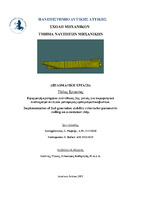Εφαρμογή κριτηρίων ευστάθειας 2ης γενιάς για παραμετρικό διατοιχισμό σε πλοίο μεταφοράς εμπορευματοκιβωτίων
Implementation of 2nd generation stability criteria for parametric rolling on a container ship

Keywords
Parametric rolling ; Παραμετρικός διατοιχισμός ; Parametric rolling resonance ; Vulnerability criteria ; Mathieu ; Following seas ; Heading seas ; Bow flare ; Bilge keels ; DampingAbstract
Οι στόχοι της παρούσας διπλωματικής εργασίας χωρίζονται σε δύο μέρη. Στο πρώτο
μέρος που έχει θεωρητικό υπόβαθρο, παρουσιάζεται η ανάλυση των βασικών
κριτηρίων ευστάθειας 2ης γενιάς για πλοία μεταφοράς εμπορευματοκιβωτίων
(container ships) από τον ΙΜΟ (International Maritime Organization) και την
εφαρμογή των κριτηρίων αυτών με βασικό γνώμονα τον έλεγχο του πλοίου ως προς
την αυθεντική απώλεια ευστάθειας και κυρίως την συμπεριφορά του πλοίου ως προς
τον παραμετρικό διατοιχισμό (parametric rolling). Αρχικά παρουσιάζεται μία
ιστορική αναδρομή της εξέλιξης των πλοίων (container ships) και μια γενική
περιγραφή των κανονισμών-απαιτήσεων ως προς τα κριτήρια ευστάθειας 1ης γενιάς από
τον ΙΜΟ. Στη συνέχεια θα αναφερθούν μέθοδοι οι οποίοι μπορούν να προσδιορίσουν
κατά πόσο ένα πλοίο είναι ευάλωτο στο φαινόμενο του παραμετρικού διατοιχισμού
(parametric rolling) παρουσιάζοντας αναλυτικά κριτήρια ευστάθειας 2ης γενιάς από
τον IMO. Αξίζει να σημειωθεί ότι θα τεκμηριωθούν κριτήρια ανάλυσης (susceptibility
criteria) για τον προσδιορισμό στο πόσο ευάλωτο είναι ένα πλοίο σε παραμετρικό
διατοιχισμό από τον Αμερικανικό Νηογνώμονα (ABS) σύμφωνα με τις επιχειρησιακές
κατευθυντήριες γραμμές του για την αξιολόγηση του φαινομένου στην εκτίμηση
πλοίων (container ships) για κάθε εφικτή ταχύτητα και κατεύθυνση τους. Στο επόμενο
κεφάλαιο γίνεται εμβάθυνση των κριτηρίων 2ης γενιάς πάνω στον παραμετρικό
διατοιχισμό, αναλύοντας τα κριτήρια ευπάθειας πρώτου και δεύτερου επιπέδου. Στη
συνέχεια παρουσιάζεται το υπολογιστικό κομμάτι στο οποίο θα προηγηθεί ανάπτυξη
υπολογιστικού μοντέλου σε σχεδιαστικό πρόγραμμα Rhino 3d από πραγματικές
διαστάσεις πλοίου σχέδιο γραμμών Lines Plan of Container ship). Κατά την
εισαγωγή του πλοίου στο πρόγραμμα θα δημιουργηθεί η γάστρα του πλοίου, όπου μας
ενδιαφέρει κυρίως η βρεχόμενη επιφάνεια του πλοίου για να μπορέσει να γίνει ο
απαραίτητος έλεγχος πάνω στον φαινόμενο του παραμετρικού διατοιχισμού. Έχοντας
δημιουργήσει τη γάστρα του μοντέλου θα εισάγουμε το rhino 3dm αρχείο σε ένα εξίσου
πολύ σημαντικό πρόγραμμα μελέτης ευστάθειας, το Maxsurf. Από αυτό το πρόγραμμα
θα γίνει η μελέτη όπου θα εξαχθούν τα υδροστατικά χαρακτηριστικά του πλοίου και
θα γίνει ο έλεγχος της ευστάθειας του πλοίου για 2 καταστάσεις φόρτωσης LC10 και
LC04 με βάση τα υφιστάμενα κριτήρια ευστάθειας (Intact stability Criteria).
Επιπρόσθετα, θα γίνει σύγκριση των υδροστατικών αποτελεσμάτων του πλοίου (μέσω
του προγράμματος Maxsurf με τα επίπεδα ευπάθειας (Vulnerability Criteria) στον
παραμετρικό διατοιχισμό που εφαρμόστηκαν σε πραγματικές μελέτες πλοίων με βάσει
τις κατευθυντήριες γραμμές του ΙMO, όπως αναφέρθηκε στο θεωρητικό μέρος της
εργασίας. Κλείνοντας θα παρουσιαστούν συμπεράσματα και προτάσεις πάνω στα
αποτελέσματα του υπολογιστικού μοντέλου που μελετήθηκε πάνω στα επίπεδα
ευπάθειας σε παραμετρικό διατοιχισμό και στην αντιμετώπιση αυτού του φαινομένου
για πλοία μεταφοράς εμπορευματοκιβωτίων (Container ships).
Abstract
The objectives of this thesis are divided into two parts. In the first part that has a
theoretical background, the analysis of the basic 2nd generation stability criteria for
container ships by the IMO (International Maritime Organization) and the application
of these criteria with the basic aim of controlling the ship with respect to the authentic
loss of stability and especially the behavior of the ship with respect to parametric
rolling. Initially presented a historical overview of the evolution of ships (container
ships) and a general description of the regulations-requirements for the 1st generation
stability criteria by IMO. Methods that can determine whether a ship is vulnerable to
the parametric rolling phenomenon will be mentioned by presenting detailed 2nd
generation stability criteria by IMO. It is worth noting that susceptibility criteria will
be documented to determine how vulnerable a ship is in a parametric fit by the US
classification society (ABS) in accordance with its operational guidelines for assessing
the phenomenon in the estimation of ships (container ships) for each feasible speed and
direction. In the next chapter there is a deepening of the 2nd generation criteria on the
parametric configuration, analyzing the first and second level vulnerability criteria.
Then the experimental piece is presented, which will be preceded by the development
of an experimental model in a design program Rhino 3d from real ship dimensions
(Lines plan of Container ship). During the introduction of the ship in the program will
be created the hull of the ship, where we are mainly interested in the wet surface of the
ship to be able to make the necessary control over the phenomenon of parametric
arrangement. Having created the hull of the model we will import the rhino 3DM file
into an equally important stability study program, the Maxsurf. From this program will
be the study where the hydrostatic characteristics of the ship will be extracted and the
stability control of the ship for 2 loading situations LC10 and LC04 based on the
existing stability criteria (Intact stability Criteria). In addition, the hydrostatic effects of
the ship (through the Maxsurf program) will be compared with the Vulnerability
Criteria levels in parametric positioning applied to real ship studies based on IMO
guidelines, as mentioned in the theoretical part of the paper. In conclusion, conclusions
and suggestions will be presented on the results of the experimental model studied on
the levels of vulnerability in parametric positioning and the treatment of this
phenomenon for container ships.

